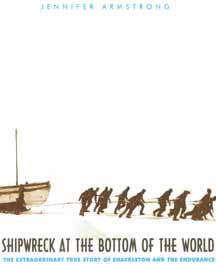Full Text Reviews: School Library Journal - 04/01/1999 Gr 6 Up-Filled with intriguing details and written with dramatic style, this riveting account of the ill-fated Imperial Trans-Antarctic Expedition reads like an adventure novel. In 1914, Sir Ernest Shackleton attempted to be the first explorer to cross Antarctica by foot from sea to sea. On the eve of World War I, he set out with a crew of scientists and sailors on a specially designed ship, Endurance, but he and his team never reached their objective. The ship became entrapped in ice, and the men were forced to abandon their mission and try to survive in the brutally harsh Antarctic wasteland for 19 months. Thanks to Shackleton's leadership, the bravery of his crew, and a lot of luck, everyone survived. The astonishing circumstances of their ordeal include a treacherous hike across miles of frozen wasteland, an 800-mile open-boat journey through savage seas, and a perilous trek across the uncharted mountain ranges of South Georgia Island. Armstrong brings all of these experiences vividly to life, frequently using quotes from members of the expedition. Excellent black-and-white photographs taken during the journey document the entire adventure story. Elizabeth Cody Kimmel's Ice Story (Clarion, 1999) has larger and more plentiful photographs but Armstrong's text is far more engaging. Kimmel relates all of the facts skillfully, but Armstrong crafts them into an unforgettable story of true heroism and the triumph of the human spirit. A book that will capture the attention and imagination of any reader.-Edward Sullivan, New York Public Library - Copyright 1999 Publishers Weekly, Library Journal and/or School Library Journal used with permission. Bulletin for the Center... - 02/01/1999 Michael McCurdy recently essayed a treatment of the Endurance’s experiences for younger readers (BCCB 9/97), and now, in time for the upcoming exhibit at the American Museum of Natural History, Armstrong tells the tale for somewhat older ones (as does Kimmel, reviewed below). The saga of Shackleton’s expedition is one of the greatest in the annals of polar exploration: after their ship was crushed in pack ice, the men survived on the naked ice, sailed 600 miles in open boats, and then split up, most remaining on a tiny rock island while Shackleton and four others sailed on another 800 miles to a Norwegian whaling station for rescue. Armstrong effectively cuts to the chase, generally leaving discussions of politics and internecine tensions (and the other side of the exploration, the men who had landed in Antarctica to lay depots for Shackleton’s crossing) to more sophisticated books, and the result is a rugged adventure story all the more compelling for being true. The author uses her sources well for provision of evocative details, such as the impact, a year after getting stuck in the ice and four months after abandoning the ship, of the discovery of a twig and the homesickness engendered by the smell of its burning. Nor does she shrink from harder truths about the fate of the ship’s sled dogs and cat mascot, but the overwhelming impression is of the skill and luck that enabled Shackleton to bring all his men back alive. Liberal employment of the expedition photographer’s pictures, including some of the most famous Antarctic images as well as portraits of the leading players, adds to the immediacy; also provided are maps and, niftily enough, the original plans of the Endurance, including deck-by-deck floor plans. Fans of Hatchet and other survival stories should get a chilly thrill from this authentic story of triumph against tremendous odds. There are no endnotes, but a bibliography is provided, as is an index. - Copyright 1999 The Board of Trustees of the University of Illinois. Booklist - 12/01/1998 Given the upcoming exhibit at the American Museum of Natural History showcasing Sir Ernest Shackleton's 1914 Imperial Trans-Antarctic Expedition, this is certainly a timely book. And what a heroic story it tells. With a crew of scientists and sailors, the renowned British explorer set sail on the Endurance hoping to land on Antarctica, then cross it by foot from sea to sea. But fate cruelly intervened, with Shackleton and his men becoming trapped in the frozen Antarctic wasteland for 19 months. Using text filled with details about daily life, quotes (unfortunately not sourced), fascinating archival photos by one of the members of the expedition, and insight into elements of science with important bearing on the story (navigation techniques, different kinds of ice), Armstrong paints a vivid picture of the ordeal. The circumstances are riveting--extreme cold, dangerous ice, a horrific 800-mile open-boat journey--yet not a single man was lost. This crosses much of the same territory covered by Caroline Alexander's recent and more extensive adult book The Endurance, which is also accessible to a high-school audience. Although Armstrong's presentation is less visceral than Alexander's and gives less sense of personalities involved, it provides a more compact, somewhat clearer understanding of the sequence of events. Bibliography. (Reviewed December 1, 1998) - Copyright 1998 Booklist. Loading...
|




